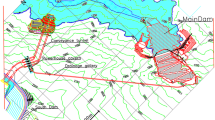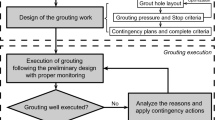Abstract
The steady-state drainage equation ofHooghoudt (1940) has adrawback that tables for the determination of the so-called’’equivalentlayer, de‘‘ are needed. These calculations arecumbersome as de is dependenton the unknown spacing. Moreover, additional head islost due to theconvergence of stream lines towards the finite numberof perforations withinthe pipe wall. Therefore, corrections are required byreplacing the actualdrain radius by its effective radius. The designers inEgypt assume that thedepth of impermeable layer is infinity which resultsin an over estimationof drain spacing that will affect the ability of thedrainage system.Van der Molen and Wesseling (1991) have developed aseries solution toreplace the Hooghoudt‘s approximation method for theequivalent depth by anexact solution. A comparison between this solution andthose of Lovell andYoungs (1984) and Hooghoudt (1940) showed that theexact solution proved tobe very accurate and efficient solution. The mainobjective of this study isto verify an accurate depth of the impermeable barrierand an effectiveradius of drain pipes which should be used in thedesign process using theexact solution.A field investigation was conducted in a study area of33,138 ha in theNorthern Delta of Egypt within Daqahliya Governorate.The results indicatethat a 5 m depth instead of infinity for theimpermeable layer in Nile Deltaand an effective radius of 90 mm should be used in thedesign process. Theuse of the exact solution for equivalent depth is acrucial issue especiallywith the high rate of on-going drainage projects inEgypt.
Similar content being viewed by others
References
Abdel-Dayem S. & Ritzema H.P. 1990. Verification of drainage design criteria in the Nile Delta, Egypt. Irrigation and Drainage Systems 4:117–131.
Amer M.H. 1990. Design of drainage system with special reference to Egypt. In: Symposium on Land Drainage for Salinity Control in Arid and Semi-arid Regions. vol. 1 (pp 39–59). Cairo, Egypt.
Cavelaars J.C., Vlotman W.F. & Spoor G. 1994. Subsurface drainage systems. In: H.P. Ritzema (Ed) Drainage Principles and Applications (pp 827–929). ILRI Publ. 16, Wageningen, The Netherlands.
Childs E.C. & Youngs E.G. 1958. The nature of the drain channels as a factor in the design of a land drainage system. J. Soil Sci. 9(2): 316–331.
Collis-George N. & Youngs E.G. 1958. Some factors determining water table heights in drained homogeneous soils. J. Soil Sci. 9: 332–338.
Dagan G. 1964. Spacing of drains by an approximate method. J. Irrig. Drain. Div. ASCE IR1: 41–67.
Dierickx W. 1980. Electrolytic analogue study of the effect of openings and surrounds of various permeabilities on the performance of field drainage pipes. Publ. 77. Rijksstation voor Land-bouwtechniek, Merelbeke, Belgium.
Dierickx W. 1993. Research and developments in selecting subsurface drainage materials. Irrigation and Drainage Systems 6: 291–310.
Gallichand J., Metzger J.F., Brichieri-Colombi J.S.A., Nosseir F. & MacIntyre D.I. 1990. Design criteria for a large-scale subsurface drainage in Egypt. Appl. Engrg. Agric. 6(4): 425–431.
Hooghoudt S.B. 1940. Algemeene beschouwing van het probleem van de detailontwatering en de infiltratie door middel van parallel loopende drains, greppels, slooten en kanalen. Versl. Landbouwk. Onderz. 46(14) B.’s Gravenhage.
ISAWIP 1988a. Subsurface drainage design criteria. Mansoura, Egypt.
Lovell C.J. & Youngs E.G. 1984. A comparison of steady-state land drainage equations. Agric. Water Management 9: 1–21.
Luthin, J.N. 1978. Drainage Engineering. Krieger Publishing Co., Inc., Huntington, New York.
Metzger J.F., Gallichand J., Brichieri-Colombi J.S.A., Nosseir F. & MacIntyre D.I. 1990. Design procedures for a large-scale subsurface drainage project in Egypt. Appl. Engrg. Agric. 6(4): 432–436.
Schwab G.O., Frevert R.K., Edminster T.W. & Barners K.W. 1981. Soil and water conservation engineering. Wiley, third edition.
Smedema L.K. & Rycroft D.W. 1983. Land drainage. Academic and Educational Ltd., London.
Soil Conservation Service 1973. Drainage of agriculture land. United States Department of Agriculture, Syosset, New York.
USBR 1978. Drainage Manual. Department of Interior, Bureau of Reclamation.
Van Beers W.F.J. 1979. Some nomographs for the calculation of drain spacings. Bull. 8, ILRI, Wageningen, The Netherlands.
Van Beers W.F.J. 1983. The auger hole method. Bull. 1, ILRI, Wageningen, The Netherlands.
Van der Molen W.H & Wesseling J. 1991. A solution in closed form and a series solution to replace the tables for the thickness of the equivalent layer in Hooghoudt’s drain spacing formula. Agric. Water Manage. 19: 1–16.
Wesseling J. 1964. A comparison of the steady state drain spacing formulas of Hooghoudt and Kirkham in connection with design practice. J. Hydrol. 2: 25–32.
Author information
Authors and Affiliations
Rights and permissions
About this article
Cite this article
Moustafa, M.M. Verification of impermeable barrier depth and effective radius for drain spacing using exact solution of the steady state flow to drains. Irrigation and Drainage Systems 11, 283–298 (1997). https://doi.org/10.1023/A:1005834422912
Issue Date:
DOI: https://doi.org/10.1023/A:1005834422912




